#Zeppelin LZ 37
Explore tagged Tumblr posts
Photo

L'Illustration (No 3772) #OTD Jun 19 1915 publishes this illustration by A. Matignon (probably Albert Matignon) showing the destruction of Imperial German Zeppelin LZ 37 after it was shot down by Reginald Warneford flying a Morane-Saulnier Type L plane
5 notes
·
View notes
Text
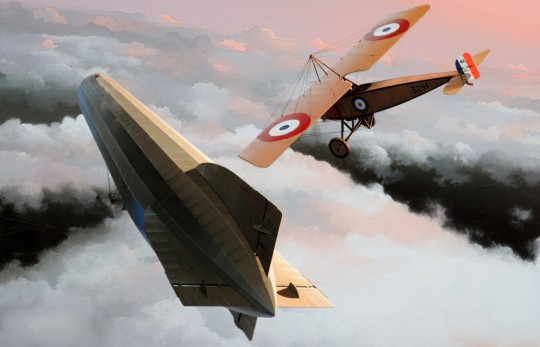
1915 06 07 Morane Saulnier Type L Warneford vs zeppelin LZ 37
this and following: external hosting right click for full resolution picture, check out text entries for download links for the entire collection
27 notes
·
View notes
Text
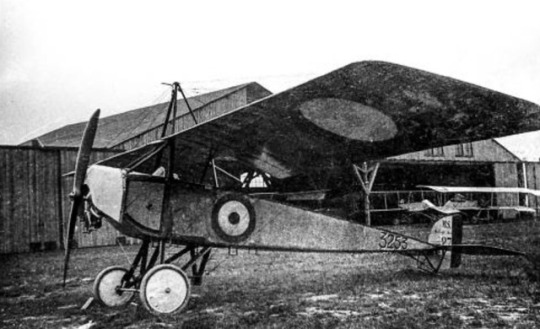
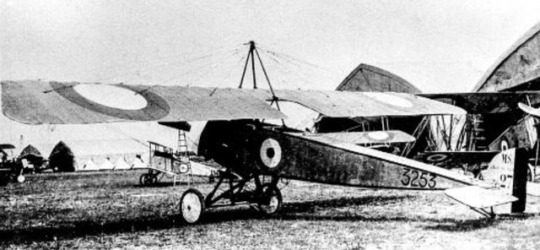
Above & Below: Two views of Morane-Saulnier L 3253 in which Warneford destroyed Zeppelin LZ.37.
Photos and caption featured in Victoria Cross: WWI Airmen and Their Aircraft: Volume 1 by Alex Revell
19 notes
·
View notes
Photo

Famous Muses & Groupies in Rock Music Pt. 37
GROUPIE: Michele Overman
Michele was born on January 30th, 1951 in New York City and was raised in Greenwich Village by a single mother, Gina. Michele and her older sister grew up as part of the bohemian, counter-culture with Gina being an avid hippie. When Michele was a teenager she started modeling for the popular boutique, Paraphernalia. She claims she’s been a rock music fangirl her whole life, with Elvis being her first celebrity crush when she was 5 years old. Only a decade later she went out with her first musician conquest: 18-year-old Ralph Scala of the one-hit wonder band, the Blues Magoos. According to Michele’s chapter of Pamela des Barres’ 2007 book Let’s Spend the Night Together, Ralph was her first everything. First time backstage, first time traveling on a tour bus, first time having sex, first time living away from home, etc. All with super hip, cool mom Gina’s blessing, of course.~ After living with Ralph in the Hotel Albert for a few months, the two broke up, but Michele was still hooked on the rockstar lifestyle.
Her next boyfriend was future Aerosmith frontman and then high schoolmate Steven Tyler, when she was 16 and he was 18. This time Steven introduced her to party drugs like pot and LSD, when he wasn’t performing in the local band Chain Reaction. In LSTNT, Michele called Steven the best lover she ever had with a lot of TMI descriptions. O_O The couple broke up after around a year of dating because she couldn’t keep up with his crazy antics off stage. Next up for Michele was Gram Parsons of the Flying Burrito Bros in 1969 for a four day long, lost weekend in southern California. It was also this weekend that she and Pamela first met and became quick friends. In LSTNT, Pamela states there was a bi-curious moment between them the night of their meeting too. Michele would only see Gram on two different occasions because of his on-again/off-again fiancée Nancy Ross.
That same year, Michele first met 21-year-old Led Zeppelin singer Robert Plant at the Gotham Hotel after a show. Every famous groupie in NYC and LA was interested in him, but he only wanted to be with Michele supposedly. They were instantly attracted to each other, but only saw each other when the band was on tour because Robert had wife Maureen and daughter Carmen back in the UK. While Michele was his main LA groupie from roughly 1969-1971, she made a hand-embroidered vest for him that can be seen in many tour photos. She also says she was around for a lot of the recording sessions of ‘Led Zeppelin III’ while on a trip to London. Robert and bandmate Jimmy Page even met Michele’s mom at a dinner date one time. She claims that there are hardly any pictures of her and Robert together back then because he was married, but I guess he got over that by 1977 when he was on the road with Audrey Hamilton, lol. Robert and Michele’s period together ended when Michele found out Robert was also having another affair with his sister-in-law Shirley Wilson (yeeesh).
Since her groupie days ended, Michele got in touch with Christianity and moved up to Portland, OR where she still resides today. Over the years, she’s reunited with both Steven and Robert at shows in Portland and LA. This time she actually got photos of herself with them. She’s also gone on to make a ton of claims in interviews—including the 2010 documentary version of LSTNT—such as: LZ’s ‘Going to California’ being written about her (actually Robert and Jimmy confirmed it was for Joni Mitchell), she was Robert’s favorite groupie (mmm, that’s probably Audrey) and that Robert allegedly told her he wishes he had chosen her over Maureen and Shirley (LOL). Michele name-dropped Pink Floyd’s David Gilmour as one of her exes in a 2010 interview with Willamette Week, but she didn’t go into any details, so who knows how true that is.
#michele overman#groupies#steven tyler#robert plant#she comes off SO badly in the lstnt doc#tbh i don't get why ppl like her#maureen and audrey >>#musesandgroupiesseries
76 notes
·
View notes
Link
Funny thing, Led Zeppelin was HUGE in my teen years. I had friends who, when I went to their houses, had Led Zeppelin, seemingly, playing non-stop. I thought at the time, OK, if I hear (that song) I’m going to scream. Later, I would learn that (that song) was Kashmir. Now one of my favorite LZ songs.... my god, those strings, Plant’s vocals, if only ANY of today’s singers/bands could come up with something as powerful, unique, meaningful. Listening to this now, Kashmir is ridiculously good. Bonham is insanely great. The greatest IMO. (Not until just now did I realize it was 8:37 long. Fucking masterpiece.) Stairway to Heaven is 8:03. And people complained about Queen’s Bohemian Rhapsody being 6 minutes long??
Stairway to Heaven is, of course, a favorite, for so many reasons. The lyrics, Page’s solo, Bonzo killing it, as always, Plant’s vocals. Black Dog is another favorite.
Bonham on drums and Page on his guitar shine in Black Dog. One of my favorites. I’m not sure any band ever had what Led Zeppelin had. In sync, times infinity. Truly.
What gets me the most about them is the synergy. They were meant to be together and create the music they did. Yet, the fact that that Plant, Page, and Jones chose to disband after John Bonham’s tragic death is what makes this band, and the people that make up the band so special. They could’ve replaced Bonham (with no one a fraction as talented) to keep things rolling. Yet when Bonham passed they knew the sound could never be replicated, but more importantly, John Bonham was irreplaceable. They disbanded. Bravo.
Why do other bands find it so easy to replace a pivotal member? Queen, the band QUEEN, ended after Freddie Mercury left us. They still tour as “Queen” plus Adam Lambert - and nothing against Lambert, he has always been gracious and completely respectful of Freddie, saying he is not singing as or replacing Freddie, but more as a tribute to him in his own way. Not sure what the rest are doing except cashing in on the supreme showman and ultimate vocalist. As for other bands who’s stars didn’t pass but simply left, for whatever reason, i.e. Journey - again, Journey ended when Steve Perry left. There is no Journey without Steve Perry (even though they tried to get someone who sounded like him - cheap) just as there is no Queen without Freddie Mercury.
Loyalty. Integrity. Respect.
Good Times Bad Times, though not one of my top 5 LZ songs, it crazily shows the connection and power of Page and Bonham. They are both insane on that track.
But, the ultimate Bonzo song is Whole Lotta Love. Just listen. Just listen. Oh Em Gee. Page too, of course.
Watch how Jason Bonham (John Bonham’s son) is received by the remaining three, when Jason, along with Heart’s incomparable Ann Wilson, and sister Nancy, and Shane Fontayne bravely performing Page’s solo quite well. Click the link below to watch. That choir really shook Plant. (I get a kick out of Regina, David Letterman’s wife keeping an eye on how they’re reacting. I love Dave, and therefore, his wife must be amazing.)
LED ZEPPELIN at KENNEDY CENTER HONORS - Ann Wilson, Nancy Wilson, Jason Bonham, Shane Fontayne, et al.
For whatever reason (need there be one?) my favorite Led Zeppelin song is Immigrant’s Song. It’s raw, I love to lyrics (couldn’t be more true today than they were 500 years ago.) It’s in your face for 2 minutes, plus a some. The whole band going full speed. If anyone ever doubts Plant’s vocals - just give these lyrics a try at the same octaves. See?? He gets a lot of focus because he’s (he is/he was) the lead vocal and he talked a lot more than everyone else but he has the pipes to back it all up.
Thank the goddess for those 12 years of music they made. All of it. Goddamn, Shangri-La.
#led zeppelin#ledzeppelinsongs#led zepplin lyrics#ledzeppelin#robertplant#robert plant#jimmy page#jimmypage#johnbonham#john bonham#jason bonham#jasonbonham#heart#ann wilson#annwilson#nancy wilson#shane fontayne#kennedy center honors#kasimir#immigrants song#blackdog#black dog#wholelottalove#whole lotta love#stairwaytoheaven#stairway to heaven#queen#freddie mercury#adam lambert#freddie
0 notes
Text
Arti bergaya dengan kaos musik
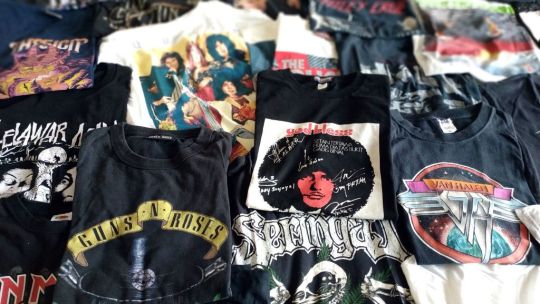
Bermula dari hobi, siapa menyangka kaos band ternyata bisa menjadi investasi bagi pemiliknya. Pun menjadi bentuk dukungan nyata bagi kelangsungan hidup musisi.
“Saya mulai membeli kaos musik sejak masih SMA. Sekarang sudah punya tiga anak,” ujar Reland (37), salah satu kolektor kaos band saat kami temui di Rock Nation, sebuah toko penjual kaos musik/band lokal dan internasional yang beralamat di Jl. Anggrek Garuda, Slipi, Jakarta Barat, Selasa (3/7/2018) siang.
Rock Nation diprakarsai Ary Budiman bersama I Nyoman Satriawijaya. Duo ini mulai menyeriusi bisnis penjualan kaos musik sejak 2016 dengan mendirikan perusahaan bernama PT Memorabilia Musik Indonesia.
Reland siang itu sejatinya mau jajan rock. Ini istilah untuk menyebut kebiasaan membelanjakan uang untuk barang-barang yang berkaitan dengan musik rock. Kaos musik salah satunya.Niat berbelanja diurungkannya musabab tak menemukan kaos incaran sesuai ukuran badannya. “Saya langganan beli kaos di Rock Nation sejak dua tahun silam,” katanya.
Di hadapan Reland berjejer kaos-kaos dari musisi lokal dan mancanegara. Harganya bervarisasi antara Rp160 ribu hingga Rp350 ribu.Mengenakan kaos resmi dari band atau musisi merupakan bukti kecintaan dan dukungan untuk keberlangsungan karier sang idola.
Hingga saat ini Reland mengaku jumlah kaos band koleksinya masih berjumlah puluhan. Tak sebanding dengan milik Ary yang saking banyaknya kemudian memenuhi lemari. Oleh sebab itu, Ary berpikir untuk menjual sebagian kaos-kaos miliknya.
Sebagai permulaan Ary menjajakan kaos-kaosnya di media sosial dan forum-forum daring seperti Kaskus.
Merasa potensi bisnis berjualan kaos band punya masa depan cerah karena bukan tren sesaat, lahirlah Rock Nation yang mengantongi lisensi resmi dari distributor merchandise besar seperti Bravado dan Live Nation Merchandise.
Berbelanja kaos band resmi band atau musisi merupakan salah satu cara mendukung perjalanan karier musisi, selain tentu saja dengan ikut membeli album asli dan tiket pertunjukan.
Dalam beberapa contoh, hasil penjualan kaos band tetap bisa memberikan benefit kepada personel --ataupun ahli warisnya-- sekalipun band bersangkutan telah bubar.
Beberapa band yang bisa dijadikan contoh, antara lain Nirvana, The Beatles, atau The Grateful Dead. Untuk lingkup nasional, kelompok Puppen dan Homicide juga bisa jadi rujukan. Penjualan aneka merchandise mereka tetap jalan meskipun tak lagi aktif berkarya.
Pemasukan dari hasil menjual album musik semata kini tak bisa lagi diandalkan. Mata pisau yang jadi pemangkasnya adalah versi unduh gratis alias bajakan dari karya musik mereka.
Bagi hasil dari layanan pengaliran musik juga belum terlalu signifikan, terutama bagi musisi atau band di kancah sidestream yang belum punya basis massa luas.
Tracy Lauren Marrow alias Ice T, rapper dan produser musik legendaris, dalam salah satu kicaunya melalui akun @FINALLEVEL menulis bahwa seorang seniman hanya menghasilkan sekitar 0,007 sen dari setiap lagunya yang terputar di Spotify.
Pada titik inilah hasil penjualan merchandise menjadi krusial. Terlebih dewasa ini kesadaran untuk mengenakan kaos asli terus meningkat. Para penggemar memafhumi bahwa membeli kaos bajakan atau berlisensi resmi tak membuat musisi idolanya mengantongi duit sepeser pun.
Semisal Reland yang selalu membeli kaos asli dari penjual yang mengantongi lisensi untuk menjual merchandise band.
“Pernah sih sekali beli kaos The Stone Roses versi bootleg (bajakan,red.) waktu nonton mereka konser di Jakarta, 2013. Itu juga terpaksa karena gue sudah kehabisan kaos aslinya. Dan rasanya memang beda kalau pakai kaos orisinal,” kata Reland beralasan.
Ada kebanggaan tersendiri ketika versi orisinal kaos band favorit menempel di badan. Sebagian malah menganalogikannya sebagai fashion statement.
“Memakai kaos band seperti sebuah pemberitahuan bahwa lo menyukai band tertentu. Kalau cuma mendengarkan albumnya kan susah bagi orang-orang mengetahui lo suka band apa,” ujar Soleh Solihun saat mengunjungi kantor Beritagar.id dalam rangka promosi film Mau Jadi Apa? (21/11/2017).
Mantan wartawan musik yang kini menjadi pemain dan sutradara film itu mengaku punya sekitar 300an koleksi kaos band. Semua tersimpan rapi dalam lemarinya. "Gue enggak ada niat menjual kaos-kaos gue itu," ujarnya.

Saat menjadi salah satu pembicara dalam dikusi mengenai merchandise band di Archipelago Festival di Soehanna Hall, Sudirman Central Business District, Jakarta Selatan (15/10/2017), Arian Arifin --vokalis Seringai-- menyebut pemasukan bandnya dalam setahun dari penjualan kaos band mencapai Rp540 juta.
Dijelaskan Arian, dari rerata harga jual satu kaos yang dibanderol Rp135 ribu, Seringai yang bersiap meluncurkan album terbaru mendapatkan untung Rp56.250.
Setiap tahun mereka meluncurkan 24 desain --satu bulan dua desain-- yang masing-masing diproduksi sebanyak 400 lembar. Lantaran banyak peminat, sering kali dua item tersebut ludes sebelum dua desain baru berikutnya meluncur ke pasaran.
Beberapa band lain yang turut menikmati pemasukan dari hasil penjualan kaos, antara lain Deadsquad, Burgerkill, The Sigit, Kelompok Penerbang Roket, dan Endank Soekamti. Raisa yang notabene solis tak kurang juga ikut memproduksi sendiri merchandise-nya.
Laris manisnya penjualan kaos tentu saja berbanding lurus dengan kepopuleran band. Semakin luas basis massa yang dimiliki, kesempatan menangguk untung juga terbuka lebih lebar.
Walaupun demikian, seringkali memproduksi kaos juga dilakukan oleh band-band muda usia yang bahkan meluncurkan satu album pun. Dengan modal sendiri yang seadanya, kaos-kaos tersebut juga dimanfaatkan sebagai media promosi agar orang-orang mengetahui keberadaan band atau musikus bersangkutan. Istilahnya walking advertisement.
Dikisahkan Arian, kelompok Homicide termasuk yang mengadopsi cara ini. “Ucok (vokalis Homicide, red.) itu kerjaannya nyetak kaos terus walaupun belum rilis album.”
Alasan lain yang mendorong orang membeli kaos musik karena desainnya menarik perhatian. Kualitas bahan yang digunakan, kain maupun tinta sablonan, juga masuk dalam pertimbangan utama.
Beberapa jenama yang jadi langganan kaos band, antara lain Gildan, Fruit of the Loom, Tultex, Anvil, Delta Pro, Alstyle Apparel & Activewear, Wild Oates, dan Hanes.
Untuk jenis tinta sablon, plastisol masih menjadi favorit karena gambar yang dihasilkan bisa menyerupai aslinya. Maklum model desain kaos musik kebanyakan berasal dari gambar atau ilustrasi yang menjadi sampul album.
Sebagai band yang sangat memerhatikan pentingnya arti kaos band, mengingat semua personelnya juga doyan beli kaos band, Seringai tahu betul cara memanjakan penggemar loyalnya.
Saban beraksi di panggung, tim dari divisi merchandise akan hadir di sana menjajakan kaos eksklusif alias dicetak terbatas.
Desain kaos tersebut tidak tersedia di Toko Lawless Jakarta, daring maupun luring. Hanya bisa didapatkan ketika menyaksikan penampilan langsung Seringai.
Ekseklusifitas jadi salah satu alasan selembar kaos jadi primadona banyak orang, terutama kolektor.
Tak peduli berapa ongkos yang harus dikeluarkan, kaos jenis ini tetap saja jadi incaran. Hal yang membuat selembar kaos band kelak bisa menjadi investasi bagi pemiliknya. Tengok saja harga kaos-kaos beratribusi rare yang dijajakan melalui ebay, situs web berjualan daring.
Selembar kaos berwarna dasar putih milik grup The Rolling Stones bertuliskan “Stones at Knebworth 76” terjual dengan harga $1.500 atau sekitar Rp21,4 juta.
Harga itu belum seberapa dibandingkan banderol untuk kaos Led Zeppelin yang juga dari festival musik Knebworth.
Kaos berwarna hitam bersapu tulisan “LZ Knebworth” pada bagian depan dan “Led Zeppelin Back Stage Pass 79” di sisi belakang itu terjual $10 ribu (Rp142,9 juta). Padahal sang penjual mengaku membeli kaos tersebut hanya seharga $123 (Rp1,7 juta).

Dalam perjalanannya, sebagian besar yang menjadi incaran kolektor memang kaos konser atau tur.
Faktor penyebabnya karena desain-desain kaos setiap rangkaian tur antara destinasi yang satu dengan lainnya kerap berbeda. Itu menjadikannya khas dan eksklusif. Seiring waktu, kaos tersebut bisa melesat jadi barang langka yang mahal harganya.
Jika melongok sejarah perjalanan musik, Grateful Dead pantas disebut sebagai band pertama yang serius menangani penjualan merchandise.
Kala band-band lain emoh melirik sektor ini karena penjualan album musik dinilai lebih menggiurkan, band bentukan 1965 di Palo Alto, California, AS, ini mulai menjajakan kaos-kaos setiap destinasi konser mereka.
Dituliskan Amber Easby dan Henry Oliver dalam buku The Art of the Band T-Shirt (Simon Spotlight Entertainment, 2007), musisi seperti Elvis Presley, The Beatles, atau The Monkees sebenarnya sudah punya kaos-kaos bertuliskan nama mereka.
Hanya saja tidak ada yang spesial dari penjualan kaos band tersebut karena pengelolaannya tidak dilakukan secara profesional.
Orang-orang bebas memproduksi sendiri kaos band-band tanpa harus membayar royalti. Sebagai misal, peredaran kaos-kaos The Beatles versi bootleg lebih banyak dibandingkan yang resmi.
“Pada era 70an, menjual kaos musik masih bukan sesuatu yang keren. Jadi kami harus sangat hati-hati saat memulai bisnis ini,” ujar Dell Furano (66), tokoh yang dianggap sebagai pionir penjualan kaos band.
Awal kisahnya terjadi saat Furano (66) masih bekerja di gedung pertunjukan Winterland Ballroom, San Francisco, AS, milik promotor musik Bill Graham. Suatu ketika, pacar Bill Kreutzmann (drummer Grateful Dead) mendatangi Graham dan mengutarakan niat menjual kaos-kaos band pacarnya sepanjang konser berlangsung.
Graham menyuruh Susila, nama kekasih Kreutzmann, untuk membicarakannya kepada Furano yang ternyata menyambut dengan baik ide tersebut.
Percobaan pertama menjual kaos the Dead --sebutan lain untuk Grateful Dead-- yang bercorak ikat celup alias tie dye khas generasi bunga ternyata cukup berhasil.
"Semula saya enggan menyetujui usulan tersebut sebab khawatir kami tidak akan mampu bersaing dengan dengan popcorn dan Coca-Cola," kenang Furano. "Ternyata banyak yang berminat dengan kaos-kaos yang kami jual.”
Tak hanya menjual kaos-kaos dengan desain unik dan berbeda pada setiap konser, mereka juga bergerilya menitipkannya ke toko-toko musik di sekitar San Francisco.
Berangkat dari momen tersebut, Ferano dan Graham lalu mendirikan Winterland Productions pada 1974 yang khusus menjual merchandise band.
Dari awalnya hanya coba-coba, kini bisnis penjualan merchandise meningkat pesat dan melintasi berbagai benua. Memasuki berbagai ruang dan kondisi.
Menemukan orang yang memakai kaos band saat mengikuti car free day, antrean nonton di bioskop, belanja di pusat perbelanjaan, terlebih saat berlangsungnya festival atau konser musik adalah kelaziman.
Menurut hasil survei Licensing Industry Merchandisers Association (LIMA), pada 2016 pemasukan dari penjualan merchandise secara global menembus angka $3,1 miliar AS (Rp44,5 triliun). Meningkat dari capaian tahun sebelumnya yang mencetak $2,83 miliar AS. Sungguh menggiurkan.
Sekarang bahkan ada sebuah acara khusus tempat penjual dan pembeli/kolektor kaos band berkumpul.
Acara bernama “Band T-Shirt Day Indonesia” pertama kali diselenggarakan pada 2016 di Rooftop Plaza Semanggi (18/12). Setahun berselang, acara dipindahkan ke Mall Kuningan City (16-17/12). Tahun ini acara serupa juga sudah mulai dipersiapkan.
Membeli kaos band bukan hanya berlangsung di toko-toko yang mengantongi lisensi resmi, tapi hingga ke lapak-lapak yang menjual pakaian impor bekas alias second.
Jika beruntung, terkadang menyempil satu kaos band produksi lawas alias rare yang bisa ditebus dengan harga miring. Tak peduli jika kaos tersebut sudah belel, asal tetap orisinal biasanya akan tetap terangkut dalam kantong belanjaan.
“Musik sudah menjadi bagian dari budaya populer. Sekarang orang-orang yang berbelanja (barang-barang terkait musik) tidak terbatas pada penggemar musik saja,” ujar Marty Brochstein, Vice President LIMA.
Demikianlah, kaos musik kini bukan sekadar untuk bergaya agar tetap mengetren. Lebih dari itu, ada sumbangsih kepada musisi dari tiap lembar kaos yang dibeli. Jika ingin menjualnya kembali, pemilik malah bisa menjadikannya investasi seperti halnya Ary Budiman.
#musik#kaosband#kaosmusik#jajanrock#rocknation#merchandise#musictshirt#lisensi#grateful dead#seringai#homicide#puppen#raisa#the sigit#kelompok penerbang roket#burgerkill#bootleg#bravado#live nation#hanes#fruit of the loom#gildan
0 notes
Photo

My week in photos part 37. Is that Eurovision on TV? Photo 1: 1955 Ray Harryhausen's monster from It Came From Beneath The Sea, or to make it contemporary, fuck the police Photo 2: Toys R'us 2018, by @scottlistfield Photo 3: "Onions" Photo 4: Exposição do mundo português, Lisboa, 1940 Photo 5: Unknown author. Maybe Lady Linda? Photo 6: Winter flowers by Gilbert & George Photo 7: Pablo Picasso Wearing A Cow’s Head Mask On Beach, 1949 Photo 8: I don't know anything about this Photo 9: Los Campeones Justicieros (1971) Photo 10: Graf Zeppelin LZ-127 and boat from the Soviet icebreaker Malygin at Franz-Josef Land. Photo (presumably) by one Dr. Aschenbrenner #art #illustration #strange #moonandme https://www.instagram.com/p/CARGVySpnjO/?igshid=gki301bhoc0e
0 notes
Text
BOB LECKIE: Zeppelin Strafer
One of Canada’s many distinguished airmen of the First World War, Robert Leckie was born in Glasgow, Scotland on April 16, 1890; his family emigrated to Canada in 1907. When not working at his uncle’s firm, John Leckie Ltd., maker of fishing nets, he developed a passion for tennis.
When war broke out Bob Leckie trained at his own expense at the Curtiss Flying School at Toronto Island, followed by advance training at Chingford, England. On June 16, 1916 his rank of flight sub-lieutenant was confirmed and three days later he was posted to the Royal Naval Air Service (RNAS) air station at Great Yarmouth, near Norwich, England. Flying anti-submarine patrols over the North Sea, Leckie gained a reputation for reliability in the most adverse conditions. His greatest claim to fame, however, involved another adversary — Zeppelin airships.
Ferdinand Graf von Zeppelin’s quest to develop a large duraluminium-framed, controllable, lighter-than-air ship finally bore fruit in 1900. By the First World War, Zeppelins had developed into viable reconnaissance platforms and on August 6, 1914 army Zeppelin Z.VI bombed Liège, Belgium. In that same month Konteradmiral Paul Behncke, deputy chief of the German naval staff, proposed bombing Britain and was supported by Grossadmiral Alfred von Tirpitz, who wrote, “The measure of success will lie not only in the injury which will be caused to the enemy but also by the significant effect it will have in diminishing the enemy’s determination to prosecute the war.” Kaiser Wilhelm II finally approved of the plan on January 7, 1915, and on the 19th naval Zeppelins L.3 and L.4 dropped the first bombs on English soil. On the night of May 31 Army Zeppelin LZ.38 was first to strike London.
Although material damage was modest, the very arbitrary nature of the civilian casualties the airships’ bombs inflicted raised public outcries for the government to “do something.” That in turn spurred the British to develop an air defence system that would ultimately incorporate searchlights, anti-aircraft artillery and aeroplanes. It also compelled both the Army and Royal Navy to divert at least some of their aerial assets from the Western Front to Home Defence. In that respect, the “Zeppelin menace” constituted history’s first aerial terror campaign. Moreover, between the morale factor, the occasional damage done and the resources diverted to countering them, the Zeppelins could also lay claim to being history’s first strategic bombers.
At first, operating at high altitudes at night made the airships difficult for Allied aircraft to intercept, but on June 6, 1915, Flight Sub-Lt. Reginald A. J. Warneford flew his Morane-Saulnier L above LZ.37 and destroyed it with bombs over Ghent, Belgium, for which he received the Victoria Cross. A more significant turning point came on September 2, 1916, when Second Lieutenant William Leefe Robinson destroyed the wooden-framed Schütte-Lanz airship SL.11, in flames within sight of London; he also earned a VC. Four more airships fell victim to aircraft by the end of the year, convincing the German army to abandon them in favour of aeroplanes such as the Gotha and Zeppelin-Staaken Riesenflugzeug (giant aeroplane) for attacking Britain. In the German navy, however, airships retained a fanatical advocate in their commander, Fregattenkapitän Peter Strasser, who relentlessly continued dispatching them against British targets. His hoped-for solution to the advances in aeroplane technology was unveiled on March 10, 1917, when the first of a line of high-altitude Zeppelins, L.42, made an inaugural flight to 19,700 feet.
At about that time Great Yarmouth was acquiring a new weapon of its own. On April 13, 1917, Leckie ferried in the first Curtiss H-8 “Large America” 8660, and flew in Curtiss H-12 8666 on May 7. With their original 160-hp Curtiss V-X-X engines replaced with Rolls-Royce Eagles of 250-hp and more to speed along at up to 90 mph, these well-armed, long-ranging flying boats offered fresh opportunities against the “Zepps.”
The first such opportunity arose on May 14, when L.23 and L.22 embarked on a maritime reconnaissance mission. The latter imprudently sent a wireless message upon takeoff, revealing its regular patrol route off Terschelling, located on one of the Netherlands’ West Frisian Islands. This message was intercepted by the British, who notified RNAS Great Yarmouth. At 0330 hours H-12 8666, crewed by Flt. Sub-Lt. Leckie, Flt. Lt. Christopher J. Galpin, Chief Petty Officer V. F. Whatling and Air Mechanic O. R. Laycock, took off to intercept.
At 0445 hours, Galpin spotted an airship and as Leckie took over the controls, he manned the twin forward Lewis machine guns. Leckie closed to 50 yards and Galpin fired a mix of Brock, Buckingham and Pomeroy incendiary rounds into L.22’s starboard quarter until both weapons jammed. Galpin reported that, “As we began to turn I thought I saw a slight glow inside the envelope and 15 seconds later, when she came in sight on our other side, she was hanging tail down at an angle of 45 degrees with the lower half of her envelope thoroughly alight.” L.22, veteran of 81 flights and 11 raids, was the first Zeppelin destroyed in 1917, taking Kapitänleutnant Ulrich Lehmann and 20 crewmen with it.
Unlikely as a flying boat seemed as a “Zepp strafer,” the history in which Leckie took part was repeated a month later. As L.43 — one of the new “Height Climbers” — was covering a minesweeping operation 40 miles north of Terschelling, another Great Yarmouth-dispatched H-12 — 8677 crewed by Flt. Lt. Basil D. Hobbs, Flt. Sub-Lt. Robert F. L. Dickey, wireless operator H. M. Davies and engineer A. W. Goody — spotted it at 0840 hours on June 14. Catching their quarry at a relatively low altitude, the Curtiss attacked from above and sent it down in flames, along with Kapitänleutnant Hermann Kraushaar and 23 crewmen.
As a consequence of these sea encounters, the airships were ordered to conduct reconnaissance flights no lower than 13,000 feet; however, this handicapped their ability to spot submerged U-boats or mines from that height.
Still, Strasser persisted in championing his airships and on July 8, 1918, the first of a new “X” type airship, L.70, emerged from Factory Shed II at Friedrichshafen, with seven engines producing a combined 1,715-hp and an 81 mph maximum speed, also including a 20mm Becker cannon in its arsenal. Strasser was so encouraged by its performance that, on July 18, he approached Admiral Reinhard Scheer with a plan to dispatch three “super Zeppelins” with reduced bomb loads and increased fuel across the Atlantic to bomb port facilities in New York. Scheer returned Strasser’s proposal the next day with a terse penciled response: “R.S., nein.”
On August 5, L.70, commanded by Kapitänleutnant Johann von Lossnitzer with Strasser aboard, led L.53, L.56, L.63 and L.65 on another sally against industrial targets in the British Midlands. Weather conditions — 75 degrees Fahrenheit, 85 per cent humidity and an unprecedentedly low barometric reading of 29.77 — handicapped the raiders’ ascent, while steadily decreasing west winds resulted in their arriving 60 nautical miles from the coast at 1830 hours, while there was still daylight. By then they had only reached 17,000 feet, to which Strasser compounded the danger by sending last orders to his captains by wireless at 2100 hours. At that time the Leman Tail lightship, moored 30 miles off the Norfolk coast, spotted three airships 10 miles to the north and moving west-northwest in V formation.
Britain was having a bank holiday weekend and Great Yarmouth was hosting a “grand fête” sponsored by the Royal Navy in aid of the Missions to Seamen when the air raid warnings came in. Within 35 minutes 15 aircraft were either airborne or taking off. Among the first up was Egbert Cadbury, scion of the family of chocolatiers and, like Leckie, already sharing credit in the destruction of a Zeppelin, L.21 on November 28, 1916. Now a major in the Royal Air Force, he commanded No. 212 Squadron (Land Flight) as he climbed into the cockpit of de Havilland D.H.4 A8032. Leckie, also a major and in charge of No. 228 Squadron (Boat Flight), clambered into the observer’s pit behind him. Two 110-lb. bombs were still under the wings as Cadbury hastened skyward at 2105 hours.
Sighting the Zeppelins against the fading twilight, Cadbury pulled his bomb release and climbed to 16,400 feet. At 2220 hours he approached the leading airship head-on and slightly to port so as to “avoid any hanging obstructions.” Leckie’s single Lewis gun lacked sights and his first rounds missed, but he used his fiery Pomeroy ZPT rounds to correct his aim.
“The ZPT was seen to blow a great hole in the fabric and a fire started which quickly ran along the entire length of [the] Zeppelin,” Leckie reported. “The Zeppelin raised her bows as if in an effort to escape, then plunged seaward, a blazing mass. The airship was completely consumed in about ¾ of a minute.”
L.70 fell five miles northwest of the Blankeney Overfalls bell buoy, along with Strasser, von Lossnitzer and 20 crewmen. Meanwhile, Cadbury made for nearby L.65, which had turned east and dumped its water ballast. Leckie fired at it, only to suffer a double feed jam which his hands — in minus-60-degree temperatures at that altitude — were too frozen to rectify. Cadbury raised the D.H.4’s nose to bring his twin Vickers into play, but just then his plane stalled. The four remaining airships returned home, having landed no bombs on England, but at least having survived.
Returning through 12,000 feet of cloud at night, “Bertie” Cadbury had a terrifying half hour until he spotted rows of lights pointing inland from Hunstanton and landed at Sedgeford — followed by the horror of discovering that his bombs had failed to release. Both he and Leckie were gazetted for the Distinguished Flying Cross on August 21.
Other participants in the action were less fortunate. D.H.9 D5802, crewed by Capt. Douglas B. G. Jardine and Lt. Edward R. Munday, put some 340 rounds through L.65’s rear gas cell before it climbed away, but they subsequently crashed in the sea, as did Lt. George F. Hodson in a Sopwith 2F1 Camel. All three men drowned. Additionally, Lt. Frank A. Benitz of No. 33 Home Defence Squadron, in Bristol F.2B C4698, crash-landed at Atwick aerodrome. He and his observer, 2nd Lt. H. Lloyd-Williams, were both badly injured and Benitz died the next day.
Strasser’s Zeppelin bombing campaign against Britain literally died with him in a suitably Wagnerian finale. In retrospect, Cadbury was glad that L.53 and L.65 got away, regarding their destruction as unnecessary overkill. As Leckie put it, “We accomplished our object in that the shooting down of L.70 put an end to the Zeppelin raiding of England.”
Of a total of 115 airships produced during the First World War and employed on all fronts, 53 were destroyed and 24 too badly damaged to remain operational, an attrition rate of 40 per cent. Bob Leckie, involved in the destruction of two of them, later wrote a succinct requiem:
The lesson of the airships is plain for all to read. The Germans had in their possession the most effective vehicle for fleet reconnaissance in any power’s hands at that time. It was, at the same time, just about the world’s worst strike aircraft!
After the war Leckie commanded 1 Canadian Wing on April 2, 1919. He subsequently directed flying operations on the Canadian Air Board and overseeing the development of postal and commercial air services throughout the country. Rejoining the RAF in 1922, Leckie served at the Naval Staff College and Coastal Command headquarters, also marrying an American girl he’d met on the voyage to Britain. His many interwar positions culminated in RAF Commanding Officer for the Mediterranean from Malta, but much to his subsequent regret he was recalled to Canada before things heated up there.
In February 1940 the British Air Ministry appointed him Air Member for Training in Canada — superseding Royal Canadian Air Force Headquarters — with the rank of air commodore. He took up that somewhat touchy duty in February 1941 and was subsequently promoted to acting air vice marshal. In 1942 he transferred to the RCAF, rising to chief of the air staff with the grade of air marshal on January 1, 1944. After retiring from the RCAF in on September 1, 1947 he played an active role in the Canadian Air Cadet League. A Companion of the Bath with the Distinguished Service Order, Distinguished Service Cross, Distinguished Flying Cross and Canadian Forces Decoration, Bob Leckie died in the Canadian Forces Hospital, Ottawa, on March 31, 1975, just 16 days short of his 85th birthday.
0 notes
Photo

LZ 37 becomes the first Zeppelin destroyed in air-to-air combat when it is bombed by Flt Sub-Lt Reginald Warneford, RNAS.
0 notes
Photo
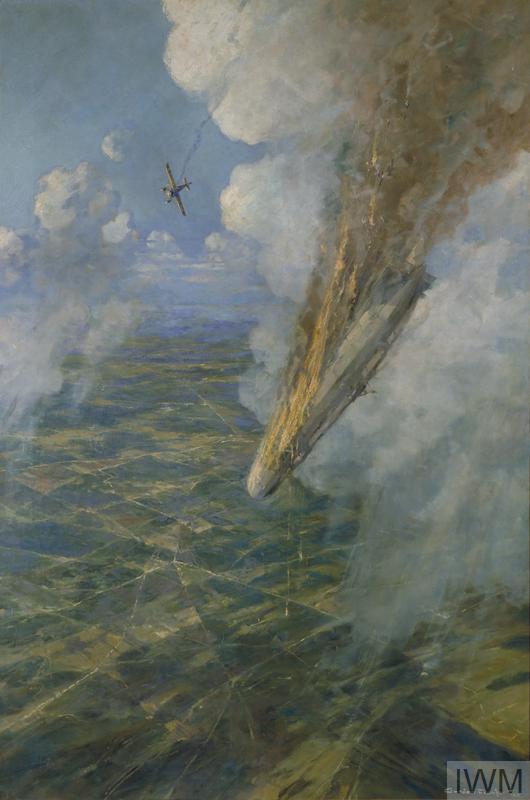
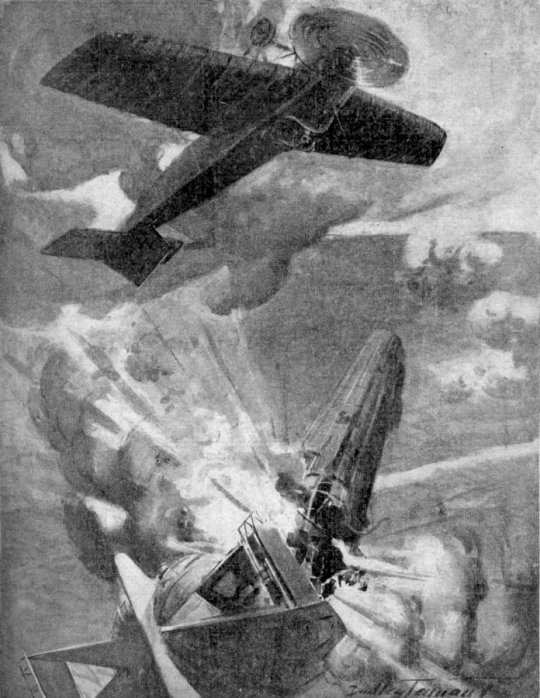
Jun 7 1915 #OnThisDay Destruction of Imperial German Navy Zeppelin LZ-37 after it was shot down by British Flight Sub-Lt Reginald Warneford. For this action he was awarded the Victoria Cross. The Airship crashed into a convent school next to Ghent, Belgium (51°3′43.2″N 3°44′54.7″E) killing 2 nuns. One crew member, Steuermann Alfred Mühler, miraculously survived after he was thrown from the forward gondola, landing in a bed
Painting by F Gordon Crosby
22 notes
·
View notes
Text
Top Ten Tumblr Posts of 2020
Number 1 - 579 Notes - Mar 1 2020
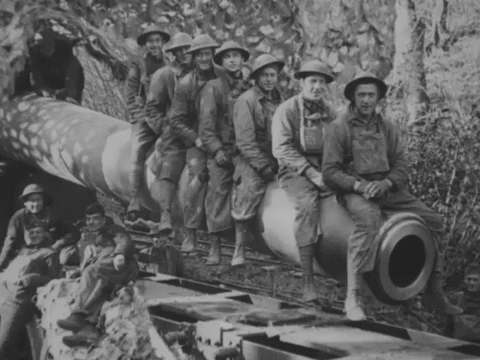
1918 Members of the 53rd Coast Artillery Regiment sit atop a 340 mm railway gun (340mm/45 Modèle 1912 gun) nicknamed “Reveille Kate”
National Archives Identifier: 24911 Local Identifier: 111-H-1409
Number 2 - 362 notes Jan 26 2020

Aug 27 1918 IWM (Q 11261) “A British soldier poses with a heavy shell with a chalked message ‘A Present for Jerry’ at a shell dump" August 27 1918 by Aitken, Thomas Keith (Second Lieutenant) (Photographer)
Production date: 1918-08-27
Colourized by @colorsofhistory
2nd landscape picture IWM (Q 11260) by Thomas Keith Aitken
Number 3 - 280 notes - Aug 3 2020
37mm M1916
The French called it the Canon d'Infanterie de 37 modèle 1916 TRP with the TRP standing for tir rapide, Puteaux (fast-firing, designed by the Atelier de Puteaux). The Americans adopted it into their WWI army and dubbed it the 37mm M1916.
So called History person, Army officer, @pptsapper, writes that the 37mm M1916 was in “every US infantry regiment.” That they “had a battery (4-6 guns) of 37mm guns - or “one pounders” as the soldiers called them - as organic direct fire support. They were deadly accurate out to 1500-1600m, firing 25-30 rounds a minute.”
The 37mm is in one of the most iconic images of American forces during WWI this 1918 photo, ARC Identifier:531005

Number 4 - 268 notes - Mar 23 2020
Problems pronouncing battlefields on the Eastern Front

Number 5 - 253 notes Feb 4 2020

One of only two Becker Type M2 20 mm cannons used by the Austro-Hungarian Army. These auto-cannons were used on the Italian Front late in the war for anti-air defence. (Also note the amazing number of “Kappenabzeichen” on the gunner’s cap) - @PikeGrey1418
Number 6 - 200 notes - Oct 25 2020
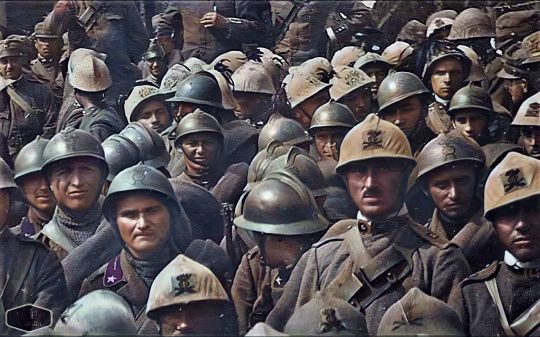
Italian soldiers gathered together for a photograph during the Battle of Vittorio Veneto, from Oct 24 1918 to Nov 4 1918 when Austria dropped out of the #WWI.
Number 7 - 196 notes - Mar 2 2020
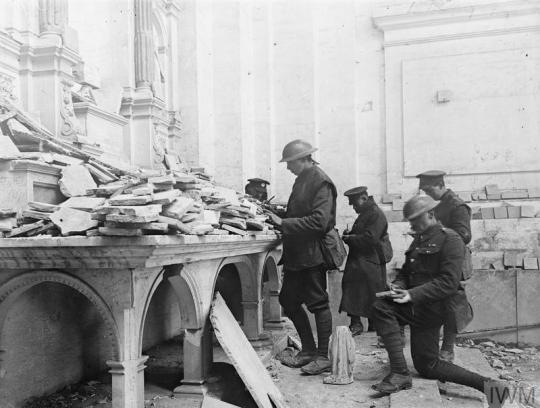
Number 8 - 196 notes - Jan 30 2020
Mar 2 1918 IWM (Q 10288) “British soldiers writing on slabs of fallen stone in Arras Cathedral" Mar 2 1918
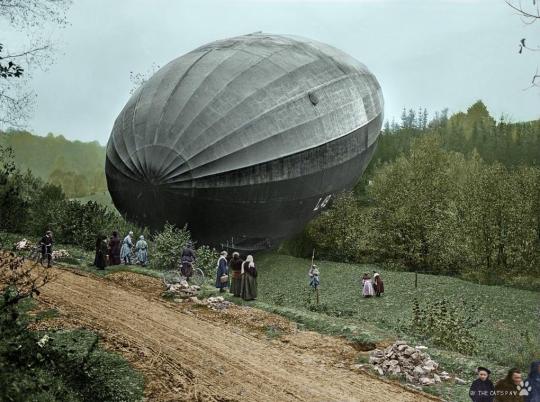
Imperial German Zeppelin L 49 (LZ 96) was forced to land at Bourbonne-les-Baines during the night of Oct 19 1917. Photo by French army photographer Albert Moreau. Often confused with Zeppelin LZ.49 that was hit by French fire, struck a house and forced to land in a forest near Ath.
Number 9 - 193 notes - Nov 9 2020

Nov 9 1918 A US official photographer takes this photo, IWM Q 57008, of an American soldier displaying a M1918 Browning automatic rifle at the Ordnance Department at Chaumont
November 9 1918-11-09
Number 10 - 178 notes - Oct 28 2020

German soldiers with Gaede Helmets, gas-masks and hand-grenades (stielhandgranates ) posing for a photograph in the Vosges mountains, 1915.
Swiss Museum
Colourized by Rui Candeias (In Colore Veritas)
75 notes
·
View notes
Text

125: France 1915, and four RNAS ‘Zepp Strafers’ pose for the camera. From left: Flight Lieutenant J.S. Mills, A.W. Bigsworth DSO, J.P. Wilson and R. Warneford VC. Mills and Wilson destroyed LZ 38, the first Zeppelin to attack London, in her shed at St. Evere on 7 June 1915, while Warneford was having a “thrilling duel at close quarters” with LZ 37. Bigsworth caught LZ 39 over Ostend on 17 May and severely damaged her (IWM Q 69479)
Photo and caption featured in Royal Naval Air Service, 1912-18 by Bradley King
7 notes
·
View notes
Text

Flight Sub-Lieutenant Reginald Warneford, RNAS, at Hendon in February 1915. He was awarded the Victoria Cross after becoming the first pilot to destroy a Zeppelin in the air when he brought down LZ.37 on 7 June 1915. He died ten days later when his aircraft crashed in France.
Photo and caption featured in Osprey Campaign • 193 London 1914-17 by Ian Castle
12 notes
·
View notes
Text

Above: Morane-Saulnier L 3253 in which Flight Sub-Lt. R.A.J. Warneford destroyed Zeppelin LZ.37.
Photo and caption featured in Victoria Cross: WWI Airmen and Their Aircraft: Volume 1 by Alex Revell
1 note
·
View note
Photo

1915 06 07 Morane Saulnier Type L Warneford vs zeppelin LZ 37 - box art Eduard
18 notes
·
View notes
Photo




Jul 8 1915 Funeral of Reginald A. J. Warneford the pilot who brought down Zeppelin LZ 37 by flying above and dropping bombs on it over Ghent, Belgium. He was awarded the Victoria Cross. He died Jun 17 1915 when his plane suffered catastrophic failure
35 notes
·
View notes